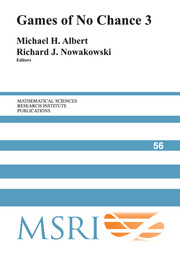The game of End-Wythoff
Published online by Cambridge University Press: 28 February 2011
Summary
Abstract. Given a vector of finitely many piles of finitely many tokens. In End-Wythoff, two players alternate in taking a positive number of tokens from either end-pile, or taking the same positive number of tokens from both ends. The player first unable to move loses and the opponent wins. We characterize the P-positions (ai, K, bi / of the game for any vector K of middle piles, where ai, bi denote the sizes of the end-piles. A more succinct characterization can be made in the special case where K is a vector such that, for some n ∈ ℤ≤0, (K, n) and (n, K) are both P-positions. For this case the (noisy) initial behavior of the P-positions is described precisely. Beyond the initial behavior, we have bi − ai = i, as in the normal 2-pile Wythoff game.
Introduction
A position in the (impartial) game End-Nim is a vector of finitely many piles of finitely many tokens. Two players alternate in taking a positive number of tokens from either end-pile (“burning-the-candle-at-both-ends”). The player first unable to move loses and the opponent wins. Albert and Nowakowski gave a winning strategy for End-Nim, by describing the P-positions of the game. (Their paper also includes a winning strategy for the partizan version of End-Nim.)
- Type
- Chapter
- Information
- Games of No Chance 3 , pp. 329 - 348Publisher: Cambridge University PressPrint publication year: 2009
- 3
- Cited by

